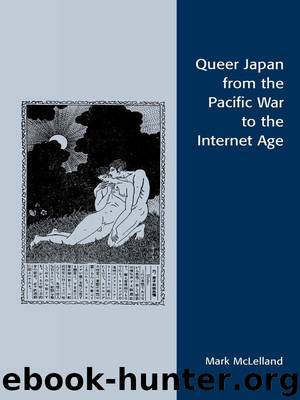Queer Japan From the Pacific War to the Internet Age by McLelland Mark J

Author:McLelland, Mark J.
Language: eng
Format: epub
ISBN: 9781461641605
Publisher: Rowman & Littlefield Publishing Group, Inc.
Published: 2013-06-26T16:00:00+00:00
THE DECLINE OF THE GEI BŌI
Despite the brief efflorescence of the blue boys and limited media interest in “cross-dressing beauties” and brother girls, gei bōi remained the most conspicuous homosexual category in Japanese popular culture until the early 1980s. During this time gei bā (distinct from homo bā, where homosexual men would meet) developed in major cities all over Japan, offering entertainment to a largely straight clientele, often comprising local office workers and tourists from the countryside. These bars, which offered cabaret-style performances, were often discussed in the press; gei bōi were featured in photo essays as well as in photography collections. Famous media tarento (personalities) who had begun their careers as gei bōi, such as Miwa Akihiro, Carrousel Maki and Peter, continued to appear on television, and new gei bōi performers continued to make the transition from the subculture to the mainstream.
Ironically, the success of one such gei bōi was to result in the demise of the category itself. In 1982, Betty, the mama-san of Betty’s Mayonnaise, an Osaka gei bā, introduced a new term, nyūhāfu (new half), as a designation for transgender performers. “Half,” or hāfu in Japanese, is used to signify individuals of mixed race, usually Japanese and Caucasian; Betty said of herself, “I’m half man and half woman, therefore I’m a new half.” Like gei bōi, nyūhāfu was a trendy fusion of two English words, but with a very specific Japanese meaning; it soon caught on in the press and began to be adopted as a self-designation by many transgender performers (McLelland 2004).
Significantly, the rise of the category nyūhāfu occurred just prior to the founding of a branch of the International Lesbian and Gay Association (ILGA) in Osaka in 1984, which led to an increased use of gei, as part of the phrase rezubian to gei (lesbian and gay) in the Japanese press, and enabled a more political conceptualization of homosexuality as a sexual minority category, akin to other minority populations in Japan. The result was that by the time of Japan’s second “gay boom” in the early 1990s (McLelland 2000a: 32-6), the terms rezubian and gei were being used in a manner very similar to their English homophones. These factors, along with the widespread adoption of gei as a self-referent by homosexual men on the Japanese Internet (McLelland 2000b: 153), mean that the term gei bōi now has an old-fashioned, provincial connotation and is seldom used except by older people.
Download
This site does not store any files on its server. We only index and link to content provided by other sites. Please contact the content providers to delete copyright contents if any and email us, we'll remove relevant links or contents immediately.
| Africa | Americas |
| Arctic & Antarctica | Asia |
| Australia & Oceania | Europe |
| Middle East | Russia |
| United States | World |
| Ancient Civilizations | Military |
| Historical Study & Educational Resources |
The Sympathizer by Viet Thanh Nguyen(4308)
The Rape of Nanking by Iris Chang(4140)
World without end by Ken Follett(3432)
Ants Among Elephants by Sujatha Gidla(3417)
Blood and Sand by Alex Von Tunzelmann(3140)
Japanese Design by Patricia J. Graham(3112)
City of Djinns: a year in Delhi by William Dalrymple(2516)
The Queen of Nothing by Holly Black(2499)
Foreign Devils on the Silk Road: The Search for the Lost Treasures of Central Asia by Peter Hopkirk(2434)
India's Ancient Past by R.S. Sharma(2417)
Inglorious Empire by Shashi Tharoor(2396)
Tokyo by Rob Goss(2390)
In Order to Live: A North Korean Girl's Journey to Freedom by Yeonmi Park(2348)
India's biggest cover-up by Dhar Anuj(2319)
Tokyo Geek's Guide: Manga, Anime, Gaming, Cosplay, Toys, Idols & More - The Ultimate Guide to Japan's Otaku Culture by Simone Gianni(2316)
The Great Game: On Secret Service in High Asia by Peter Hopkirk(2305)
Goodbye Madame Butterfly(2209)
Batik by Rudolf Smend(2128)
Living Silence in Burma by Christina Fink(2038)
